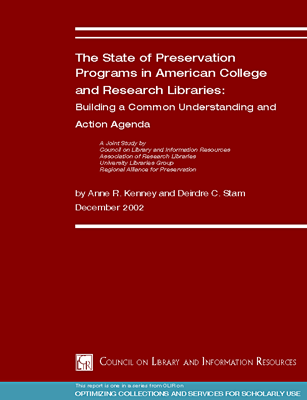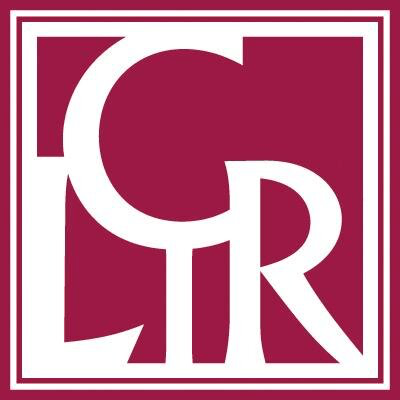The State of Preservation Programs in American College and Research Libraries: Building a Common Understanding and Action Agenda

by
Anne R. Kenney and Deirdre C. Stam
December 2002
Copyright 2002 by the Council on Library and Information Resources. No part of this publication may be reproduced or transcribed in any form without permission of the publisher. Requests for reproduction should be submitted to the Director of Communications at the Council on Library and Information Resources.
- Key Findings from Phase I
- Key Findings from Phase II
IV. Background and Methodology
V. Survey Results: Summary of Findings and Trends
VI. Site Visit Results: Summaries
VII. Appendixes
- A. IMLS Survey Form with Data; Instructions
- B. Site Visit Interview Protocol/Questions
- C. Institutions Responding to Statistical Survey, Phase I
Analysis of Site Visit Responses (not included in print edition)
Tables, Figures, and Charts
Table 1: Staffing Patterns of Preservation Activities Library-wide
Table 2: Preservation Policies and Practices
Table 3: Institutions Hosting Site Visits
Table 4: Median Library Size, Holdings, and Operations
Table 5: Preservation Expenditures Compared with Library Expenditures
Table 6: Preservation Expenditures as Percentage of Library Expenditures
Table 7: Preservation Staff Expenditures Compared with Total Library Expenditures
Table 8: Preservation FTE Staff Compared with Total Library Staff
Table 9: Preservation Administrators
Table 10: Conservation Treatments
Figure 1: Geographic Distribution of Institutional Site Visits
Chart 1: Preservation Expenditures for ARL
Chart 2: Preservation Expenditures for ILMS (all)
Chart 3: Preservation Expenditures for ULG
Chart 4: Preservation Expenditures for LG
Chart 5: Preservation Expenditures for OG
Chart 6: Contract Expenditures in ILMS Survey
Chart 7: Contract Expenditures for ARL
Chart 8: Contract Expenditures for ULG
Chart 9: Contract Expenditures for LG
Chart 10: Contract Expenditures for OG
About the Authors
Anne R. Kenney is Assistant University Librarian for Instruction, Research, and Information Services at Cornell University Library. At the time the preservation study was conducted, she also served as director of programs at the Council on Library and Information Resources. For the past decade, Ms. Kenney has done research in digitization and the digital preservation of library and archival materials. She is the coauthor of three award-winning books and many articles and reports. A Fellow and past president of the Society of American Archivists, Ms. Kenney currently serves on the Standing Committee on Cuban Libraries and Archives, a joint committee of the Academy of Sciences of Cuba and the Working Group on Cuba.
Deirdre C. Stam is director of the New York Center for Books and Reading. She is setting up a program in the history of the book for the Palmer School of Librarianship, Long Island University. Ms. Stam has pursued research into American book culture of the nineteenth century and into computer applications to art information issues. She has served on the faculties of schools of library and information science at Columbia University, Catholic University, and Syracuse University. She has also served as executive secretary for the Bibliographical Society of America and the Museum Computer Network, and was Syracuse University’s first Web master.
Acknowledgments
With funding from the Institute for Museum and Library Services, the Council on Library and Information Resources (CLIR), the Association of Research Libraries (ARL), the University Libraries Group, and the Regional Alliance for Preservation conducted a joint study to assess the state of preservation programs in American academic libraries. They were assisted by representatives from leading liberal arts colleges, land grant institutions, preservation educators, and the Preservation and Reformatting Section of the Association for Library Collections and Technical Services of the American Library Association.
Institutions targeted in this study were members of ARL (122 institutions) and the University Libraries Group (22 midsize universities), as well as 74 leading liberal arts colleges (all members of the Oberlin Group) and 20 major non-ARL land grant institutions. Anne R. Kenney, then director of programs at CLIR, served as project director. Deirdre C. Stam served as project consultant. ARL staff members Martha Kyrillidou, senior program officer for statistics and measurement, and Mary Case, director of the Office of Scholarly Communication, provided support and guidance for the survey portion of this project. Mark Young, statistics program research assistant at ARL, provided additional statistical data. An advisory committee, consisting of leaders from the partner organizations and others representing important preservation constituencies, guided this effort.
The study included both a survey of the targeted institutions and 20 follow-up site visits. Will Bridegam, Connie McCarthy, and Catherine Murray-Rust pretested the survey instrument at their institutions, and members of the Advisory Committee with ties to the targeted audience took responsibility for promoting and monitoring the survey. Appendix C lists the institutions responding to the survey. Members of the Advisory Committee who conducted the site visits were Willis Bridegam, Ellen Cunningham-Kruppa, Nancy Gwinn, Andrew S. Hart, Anne R. Kenney, Connie Kearns McCarthy, and Catherine Murray-Rust. Special thanks go to Catherine Murray-Rust, who conducted 5 of the 20 site visits. The 111 institutional participants in the site visits were very generous with their time and assistance. The institutions that hosted the site visits are listed on page 13.
Anne R. Kenney
Deirdre C. Stam
Preface
Rethinking Preservation in the Twenty-first Century
Awareness of the preservation problem has grown in American academic libraries in the past 20 years. In the 1980s, attention was drawn to the problem of brittle books and the effects of the environment and use on entire collections. In response, many libraries established preservation departments and began to plan strategies for ensuring the well-being of their holdings. Yet, as the scope of work grew, preservation activity became more specialized and isolated from the key activities of the library. Today, it seems, little has changed. Preservation treatments are increasingly sophisticated and effective, yet preservation as a core activity of libraries remains less visible than others such as cataloging and user surveys.
The information landscape has changed, thanks to the digital revolution. Libraries are working to integrate access to print materials with access to digital materials. There is likewise a challenge to integrate the preservation of analog and digital materials. Preservation specialists have been trained to work with print-based materials, and they are justifiably concerned about the increased complexity of the new preservation agenda. They cannot meet the challenges ahead without assistance from all parts of the library organization.
Libraries are society’s stewards of cultural and intellectual resources. For libraries to continue fulfilling their stewardship role, they will have to approach preservation in a new way. It must be integrated into every aspect of the library’s work. Preservation must be considered at the highest levels of the institution and reconceived in the digital environment.
Deanna B. Marcum
President, CLIR
Advisory Committee
Willis Bridegam
Amherst College
Mary M. Case
Association of Research Libraries
Ellen Cunningham-Kruppa
University of Texas at Austin
Nancy Gwinn
Smithsonian Institution Libraries
Andrew S. Hart
University of North Carolina at Chapel Hill
Anne R. Kenney
Council on Library and Information Resources
Deanna Marcum
Council on Library and Information Resources
Connie Kearns McCarthy
College of William and Mary
Catherine Murray-Rust
Oregon State University
Ann Russell
Northeast Document Conservation Center
Acronyms and Abbreviations Used in Report
| ALA | American Library Association |
| ACRL | Association of College and Research Libraries |
| ADA | Americans with Disability Act |
| AIC | American Institute for the Conservation of Historic and Artistic Works |
| AMIGOS | Amigos Library Services |
| ARL | Association of Research Libraries |
| AV | audiovisual |
| CD | compact disk |
| CIC | (Big Ten) [universities] Combined Catalog |
| CIP | Cataloging in Publication program; extended to digital objects |
| CLIR | Council on Library and Information Resources |
| CRL | Center for Research Libraries |
| CNI | Coalition for Networked Information |
| DLF | Digital Library Federation |
| EAD | Encoded Archival Description |
| FCLA | Florida Center for Library Automation |
| GPO | U.S. Government Printing Office |
| HVAC | heating, ventilating and air conditioning |
| IMLS | Institute for Museum and Library Services |
| IPI | Image Permanence Institute at Rochester Institute of Technology |
| ITS | information technology systems/services |
| JSTOR | Scholarly Journal Archive (database) |
| LC | Library of Congress |
| LG | Non-ARL Land Grant library |
| LOCKSS | (Lots of Copies Keep Stuff Safe); to safeguard Web journals |
| LP | long playing record (78 rpm) |
| MUSE | Project MUSE; Scholarly Journals Online |
| NEDCC | Northeast Document Conservation Center |
| NEH | National Endowment for the Humanities |
| NELINET | New England Library and Information Services Network |
| NYLA | New York Library Association |
| OCLC | (Formerly) Online Computer Library Center, now simply OCLC |
| OG | libraries of the Oberlin Group that chose to participate in this study |
| OLA | Ohio Library Association |
| ORBIS | Consortium of 20 libraries, Oregon region |
| PASCAL | Preservation and Access Service Center for Colorado Academic Libraries |
| RAP | Regional Alliance for Preservation |
| RLG | Research Libraries Group |
| SAA | Society of American Archivists |
| SOLINET | Southeastern Library Network |
| ULG | libraries of the University Library Group |
| USAIN | United States Agricultural Information Network |

